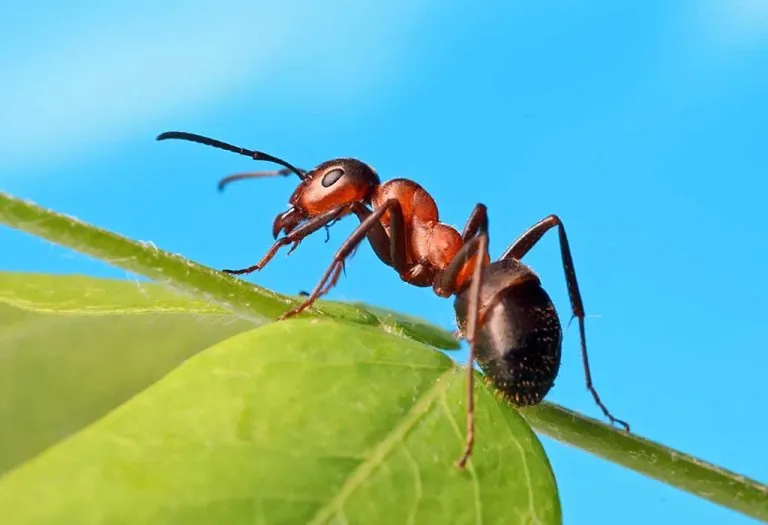23 Interesting Facts About Ants for Kids
- What Are Ants?
- Most Common Species of Ant
- Ant Anatomy
- How and Where Do Ants Live?
- What Do They Eat?
- How Do Ants Breathe?
- How Do Ants Reproduce?
- Other Amazing Facts On Ants
- FAQs
Ants are some of the most successful creatures on the planet, having colonised almost all the continents. While they are common around your house, they have some amazing characteristics worthy of learning about.
With incredible abilities, it’s no wonder ants have thrived for millions of years. These tiny insects are truly remarkable, and learning about them can be both fun and educational for kids. Ants may be small, but they are mighty! So next time you see an ant, take a moment to appreciate its strength, teamwork, and intelligence. Here are some cool ant facts for kids and ant information that is sure to surprise them.
What Are Ants?
Ants belong to the insect family Formicidae and are classified as invertebrates. Depending on species and role within the colony, their lifespan can range from just a few weeks up to multiple years.
Most Common Species of Ant
While many ant types exist, a few are particularly widespread due to their adaptability and close association with humans. Below are three of the most common ant species you’re likely to encounter.
- Black Garden Ant (Lasius niger): A familiar sight in backyards and parks, these small black ants build nests in soil and under stones. They feed on insects and sweet substances, often invading homes in search of food.
- Argentine Ant (Linepithema humile): Originally from South America, this invasive species forms massive supercolonies. They outcompete native ants and are frequently found in urban areas, trailing along sidewalks and walls.
- Red Imported Fire Ant (Solenopsis invicta): Known for their painful stings, these aggressive reddish-brown ants build large mound nests. They thrive in warm climates and can damage crops, electrical equipment, and local ecosystems.
Ant Anatomy
Ants may be small, but their bodies are perfectly designed for survival and teamwork. Like all insects, they have three main body segments, but their anatomy includes specialised features that make them efficient hunters, builders, and colony members.
- Head: The head houses the ant’s brain, compound eyes, and powerful mandibles (jaws) used for carrying food, digging, and defence. Some species also have antennae for sensing their environment. The jaws open and close almost like scissors and exert enough force to squeeze the juice out of food.
- Thorax: This middle segment anchors six strong legs, allowing ants to run quickly and climb with ease. Winged reproductive ants (like queens and males) also have wings attached here during their mating phase.
- Abdomen: The abdomen contains vital organs, including the heart and digestive system. In some species, it also holds a stinger (like fire ants) or acid-spraying defences (like wood ants).
- Antennae: These thin, flexible feelers detect chemicals (pheromones), vibrations, and even air currents, helping ants communicate and navigate without sight.
- Exoskeleton: A tough outer shell made of chitin protects ants from injuries and retains moisture. Unlike human bones, it doesn’t grow, forcing ants to moult as larvae.
- Metapleural Gland: Unique to ants, this gland produces antibiotics that keep their crowded nests disease-free—a key to their colony’s success.
How and Where Do Ants Live?
Ants are highly adaptable insects that live in colonies, often building intricate nests underground, in rotting wood, or even inside homes. They thrive in nearly every environment—from rainforests to deserts—except extremely cold regions like Antarctica. Worker ants constantly forage for food while the queen lays eggs, creating a well-organised society where each ant has a specific role. Some species, like carpenter ants, tunnel through wood, while others, like fire ants, construct visible soil mounds.
What Do They Eat?
Ants are opportunistic eaters with diets varying by species, but most are omnivores that consume both plant and animal matter. Common foods include:
- Sweet substances (honeydew from aphids, nectar, fruit juices)
- Proteins (dead insects, small invertebrates, meat scraps)
- Seeds and grains (harvester ants collect and store them)
- Fungi (leafcutter ants farm mushrooms in their nests)
Some ants even “milk” aphids for honeydew or scavenge human leftovers. Their diverse diets help colonies thrive in almost any environment
How Do Ants Breathe?
This is an interesting ant insect fact. Ants breathe through tiny holes called spiracles along their bodies, which connect to air tubes (tracheae) that deliver oxygen straight to their organs. Unlike humans, they don’t need lungs or blood to transport air—their small size lets oxygen spread efficiently. This clever system keeps them active, whether they’re digging tunnels or carrying food!
How Do Ants Reproduce?
Ant reproduction follows a fascinating winged courtship. Once a year, young queen ants and male drones take flight in massive swarms to mate mid-air. After this “nuptial flight,” the male dies, while the fertilised queen snaps off her wings and digs a nest to start a new colony. She lays eggs that hatch into worker ants (all female), who then care for future offspring. The queen spends years laying thousands of eggs—some species even clone themselves. Only special reproductive ants (future queens/males) grow wings to restart the cycle.
Other Amazing Facts On Ants
Here are some more ant facts for preschoolers that they need to understand about ants:
- Ants are incredibly strong. They are capable of lifting 20 to 100 times their own body weight and carrying it up everywhere, or dragging it along the ground to the colony. It’s roughly equal to an adult human being lifting a car over his head and walking home!
- Ants can travel great distances from their colonies in search of food. Some are known to go as far as 200m and return. They do this by leaving behind a trail of scent that other ants can follow and which they use to get back home.
- Ants are known to herd and nurture some species of insects in exchange for the sugary sap they produce. They are also observed to carry sap-sucking insects from one tree to another. Ants also defend a type of plant called Myrmecophytes in exchange for food.
- Ants fiercely defend their colonies. Some species have soldier ants with specialised heads that fit perfectly at their nest’s entrance. They guard the nest by sitting at the entrance and kill any other ant or insect that tries to pass through.
- Fire ants are popularly known for their aggressive behaviour and bite. Some interesting fire ant facts are that there are over 200 species of them around the world. They are also called red ants or tropical fire ants. While their bite is itchy and painful, it’s mostly harmless to humans.
- Some interesting leaf-cutter ant facts include that they can carry leaves that are 50 times their body weight and can be spotted from a distance thanks to their queues, which can be up to 30m long. They use the leaves to cultivate a special type of fungus that exists only in their colonies.
- There are so many ants around the world that for every human being, there are 1.5 million ants!
- Ant colonies also wage wars and take over other colonies. The losing colony becomes slave ants that look after the winning colony.
- When the queen of a colony dies, she is rarely replaced, and the rest of the colony dies within a matter of months.
- Ants are related to bees and wasps, and evolved from wasp-like ancestors over 100 million years ago. They’ve spread worldwide, living everywhere except polar regions like Antarctica.
- Ants are highly social insects that live in large colonies with three main roles: worker ants handle chores, a queen lays eggs, and male drones mate with the queen. There are about 22,000 ant species worldwide, all working together in organised groups.
- When the question is what do ants eat for kids? Ants eat both plants and animals, acting as scavengers and sometimes predators. Some even grow their own food by farming fungus inside their colonies using leaves.
- Ants never sleep. Instead, they take about 250 short “power naps” daily, totalling just 4-5 hours of rest! This lets colonies work 24/7.
- Some ants can swim. Fire ants form living rafts by linking their bodies together during floods, surviving for weeks on water!
- Ants have two stomachs – One for their own food, and a “social stomach” to share food with colony mates through mouth-to-mouth feeding.
- The oldest ant fossil is 100 million years old – that means ants were around with dinosaurs! The fossil was found preserved in amber.
FAQs
1. Can ants get stuck in circles like in cartoons?
Yes. When ants lose their scent trail (like on super-smooth surfaces), they may walk in a “death spiral” until exhausted. This happens because they blindly follow the ant ahead—a rare but real phenomenon called ant milling.
2. Why do some ants smell like blue cheese or coconut?
Certain species, like Turtle Ants, release weird odours when crushed. One smells like blue cheese (from mould-fighting chemicals), while Asian Bullet Ants smell like toasted coconut—a quirky defence mechanism.
3. Can ants survive in space?
NASA tested it. In 2014, ants on the ISS adapted to zero gravity by clinging to walls and “swimming” through air. They still cooperated, proving their teamwork is out of this world.
This was our list of facts about ants in English. Ants are fascinating creatures from which there is much to learn about social behaviour in organisms. Ants were here long before we arrived and have managed to colonise the globe, outnumbering humans.
Also Read:
Dog Facts for Kids
Wolves Facts for Children
Facts about Cheetah for Kids
Interesting Peacock Facts for Kids
Amazing Penguin Facts for Children
Fascinating Facts About Blue Whales for Kids
Was This Article Helpful?
Parenting is a huge responsibility, for you as a caregiver, but also for us as a parenting content platform. We understand that and take our responsibility of creating credible content seriously. FirstCry Parenting articles are written and published only after extensive research using factually sound references to deliver quality content that is accurate, validated by experts, and completely reliable. To understand how we go about creating content that is credible, read our editorial policy here.























